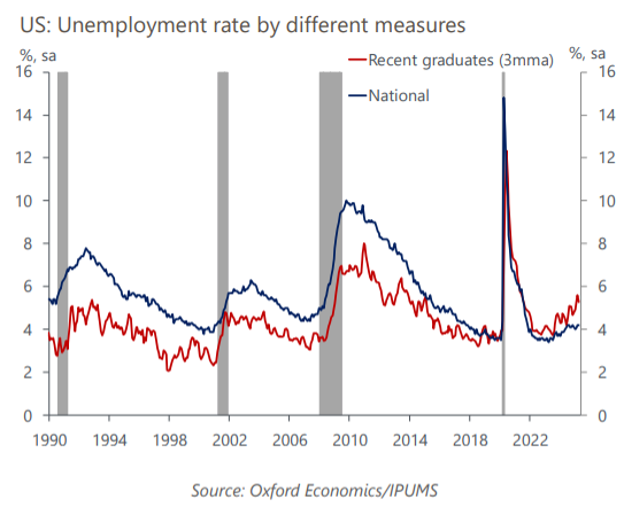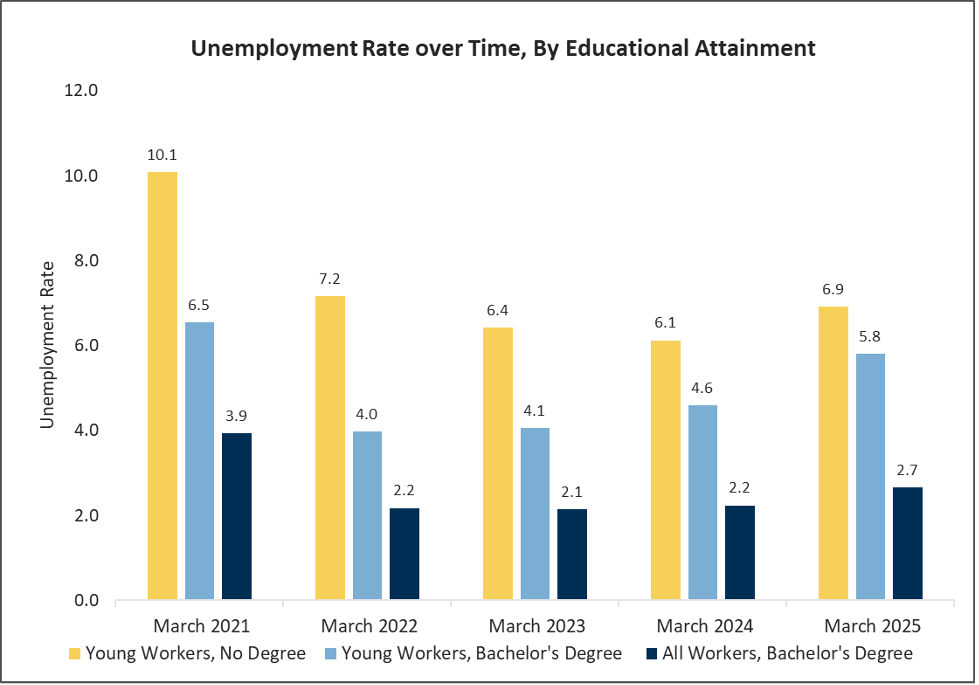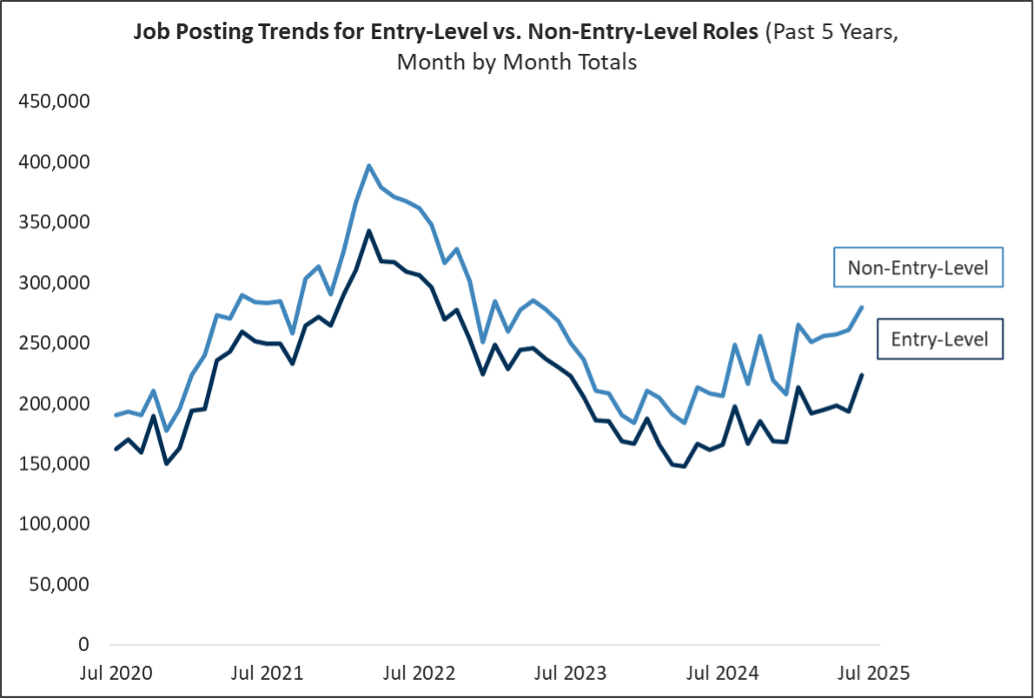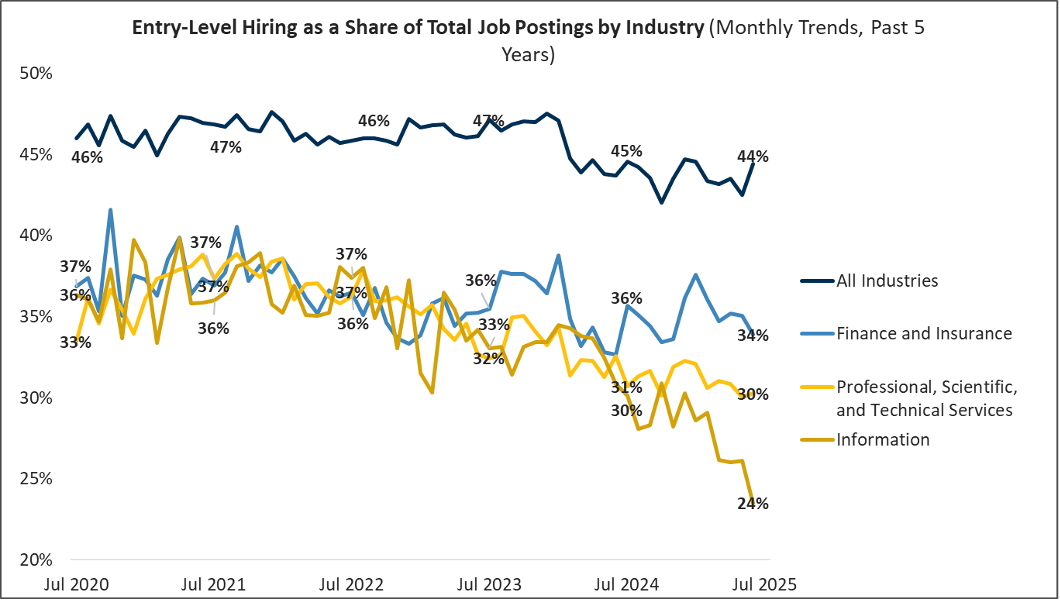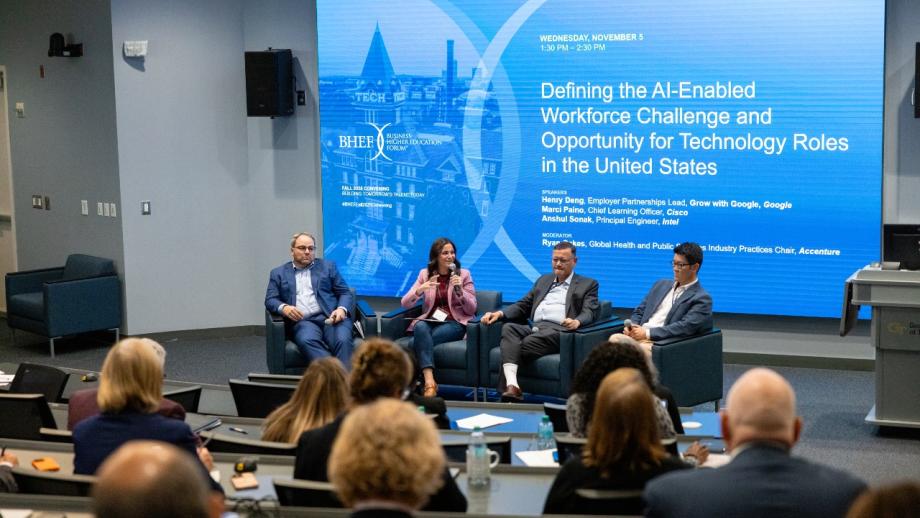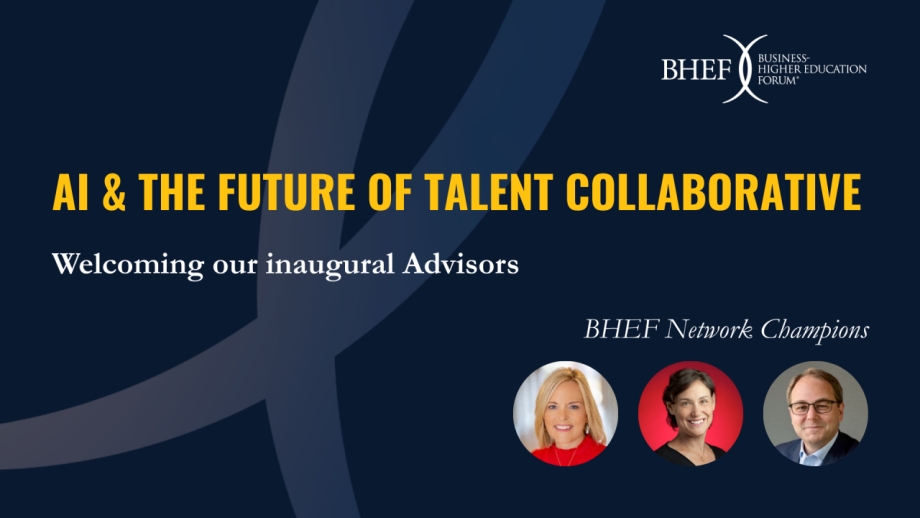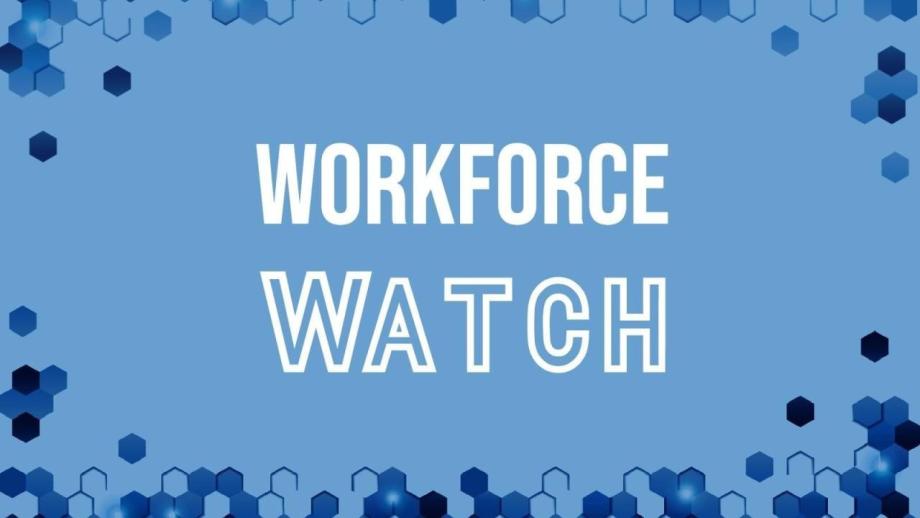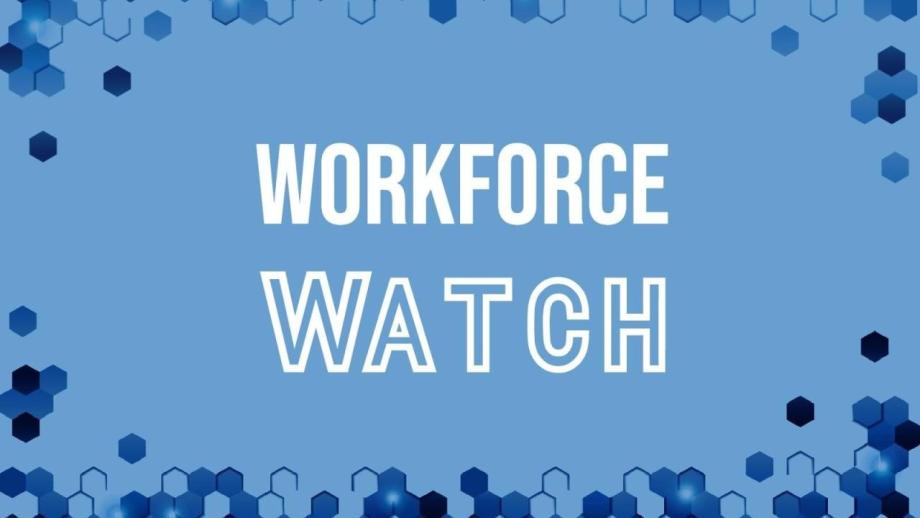AI’s impact on the workforce is playing out in real time, with knowledge workers or “white collar” professionals experiencing disruption and displacement across experienced and early career roles. This disruption to early career roles is not just about AI and is likely due to a variety of factors that impact early career hiring including overall economic uncertainty, employer preference for more experienced professionals, and reductions in training and development budgets. However, a growing set of evidence indicates that AI and automation are impacting the stepping-stone roles that once provided pathways into professional careers:
- A recent report from Oxford Economics points to signs that entry-level positions are being displaced.
- In an op-ed, LinkedIn’s chief opportunity officer noted that the bottom rung of the career ladder is breaking.
- Anthropic’s CEO predicted AI could wipe out half of entry-level
- The Wall Street Journal wrote that CEOs are “starting to say the quiet part out loud,” citing Ford’s CEO anticipating AI replacing half of white-collar workers and JPMorgan Chase expecting a 10% operations head-count reduction via AI.
- A survey by Hunt International Business School found that 89% of employers say they avoid hiring recent graduates due to a lack of real-world experience, misaligned skills, and the high cost of training.
Professionals with higher levels of education fare better in the job market overall. Bachelor’s degree holders, both at the entry-level (light blue) and overall (dark blue) consistently have lower unemployment rates than young workers without a degree (yellow). However, despite the historical consistency that higher levels of education are associated with lower levels of unemployment, that gap has recently been closing. In 2021, there was a 3.6% difference in unemployment between young workers with and without a degree and by 2025, that gap has shrunk to just 1.1%.
Source: BHEF Analysis of Data from the Federal Reserve Bank of New York
But it is not all simply a story of entry-level role reduction. At a recent Business-Higher Education Forum network roundtable, a Fortune 500 talent executive shared they are taking a “more nuanced approach to hiring, in which we are increasing hiring in some entry level roles, reducing others, and redesigning others.”
A key nuance we are seeing is that expectations of competence in entry level roles are rising and that AI will likely accelerate that dynamic in knowledge roles. At BHEF, we analyzed the skills shifts of a common entry level role in the tax and audit field, and we see an observable shift in the skills DNA from more routine tasks to higher-order tasks and durable skills. In fact, 77% of entry-level talent report they are expected to perform at a higher level due to the added capabilities of AI, despite having fewer opportunities for skills development. A new report from the Burning Glass Institute demonstrates how generative AI is reshaping career pathways and the learning curves of how workers acquire expertise over time. Their analysis describes two key categories of role impacted: growth roles (comprising 18 million US workers or ~12% of workforce) and mastery roles (29 million US workers or ~19% of workforce). Growth roles are characterized by learning progression that intensifies significantly over time as workers take on more nuanced and judgment-heavy responsibilities. These roles include legal associates, marketing specialists, and project managers, where foundational work has served as the training ground for future expertise and there is a narrowing of career entry points. Mastery roles are characterized by front-loaded learning curves and mastery of a body of codified technical knowledge at the start. These roles include network administrators, data warehousing specialists, and loan interviewers. In these roles, GenAI acts as an equalizer, compressing the time required to gain initial proficiency and enabling more individuals to qualify for such positions.
The bottom line: the expectations of entry-level talent are rising while the systems to achieve that level of context and understanding are not necessarily keeping pace.
Cutting Through the Noise: What Employers Are Signaling About Entry-Level Talent
We are seeing evidence of freezes in entry-level hiring as measured by unemployment rates. However, in relative terms, we have also started to see entry-level job postings––a signal of future intent to hire––increase, stabilizing after post-pandemic declines from 2022-2023.
Source: BHEF Analysis of Lightcast Job Postings
But the impacts look different across industries. In areas of AI-exposed knowledge work and in routine-task industries like information, professional services, finance, and insurance, unemployment among recent graduates is concentrated, and the gap between entry-level and experienced talent hiring is widening.
In the information industry, one of the sectors most exposed to AI, non-entry level hiring has remained strong, while entry-level postings have stagnated. Employers are increasingly relying on experienced talent while entry-level workers are left with fewer pathways into the field.
In the professional services, finance, and insurance industries, entry-level job postings generally follow the same trend as non-entry-level roles but at lower volumes. While the divergence isn't as stark as in the information industry, entry-level demand has not rebounded at the same pace as other hiring. This lag is mirrored in the rising unemployment rates among recent graduates in these industries, highlighting a growing disconnect between early career talent supply and employer demand.
Source: BHEF Analysis of Lightcast Job Postings
The Importance of Early Career Experiences
We have consistently seen that early career momentum matters.
- Gallup and Strada research has found that those who secure “good jobs” early in their careers earn significantly more compared to those who take a year or more to find quality employment, and they experience greater professional success over the long term.
- Social capital research has continuously demonstrated that early career exposure, network development, and mentorship also matter in early career success and throughout an entire career. As the old adage goes “it’s not just what you know but who you know.”
So, how do we need to rethink early career roles and the educational pathways to them to create early career momentum, even in an age of AI?
Strategies to Build and Empower Tomorrow’s Workforce
In a scenario with fewer or changed early career launchpad roles, we need to reimagine how colleges (and other educational providers) and industry prepare today’s learners for tomorrow’s professional success. Doing so requires a mindset shift in which companies are not passive consumers of talent but partners in talent development, not only in the short term, but the medium to long term.
1. Double down on human skills (durable, meta-cognitive, non-cognitive) and connections (social networks). The future of knowledge work requires humans to focus on doing the work that AI can’t. This work requires greater context and sector-specific domain knowledge.
We are seeing a “supervision threshold” emerge that divides the world of work. Below the threshold are the routine tasks that AI can execute with minimal human oversight. These roles include tasks like drafting standard legal documents, basic code review, and marketing copy creation. Above the threshold are the higher-order tasks that require context knowledge and judgement, such when a more complex legal structure is required, when code has an error, or when the copywriting is too generic. These skills require contextual knowledge and experience (more on that next), as well as a broad set of human literacies that can be used across professional sectors and domains.
To rise above the threshold, consider the skills that our board member and Northeastern University President Joseph Aoun outlines as essential literacies in Robot-Proof: Higher Education in the Age of Artificial Intelligence. In addition to technical and data literacies, he shares two key components of human literacy.
First, a set of “catalytic capacities” that include:
- Initiative and self-reliance
- Comfort with risk
- Flexibility and adaptability
Second, a set of “creative capacities” that include:
- Opportunity recognition, or the ability to see and experience problems as opportunities to create solutions
- Creative innovation, or the ability to create solutions without clearly defined structures
- Future innovation, or the disposition to orient toward future developments in society
The most effective approach to achieve these outcomes? Interdisciplinary models that embed skills flexibly across curriculum, that engage learners as part of networks, teams, and exploration, and that embed applied experiences in real-world contexts. Scott Carlson and Ned Laff have laid out some great examples of what this looks like in action in Hacking College.
2. Expand Applied and Work-integrated Learning Experiences. In a world with fewer entry-level experiences, we need embedded, contextual learning experiences that can scale. These can range from project-based learning and micro-internships to traditional internships and co-ops, designed for different learner, worker, and employer contexts. However, existing supply is insufficient and unevenly distributed. But we face a design and incentive challenge, with employers (and college leaders) experiencing friction in the operations, design, and financial cost of engaging in these opportunities.
Businesses, education, and intermediary organizations can and are addressing these challenges. A few notable examples of models that are promising:
- State and Regional Consortia: Increasingly states or state systems are exploring statewide, coordinated approaches designed to embed meaningful workplace experiences from employers across sectors into academic programs at scale. In New York, the state has increased its investments in providing work-integrated learning opportunities for students through its public college and university systems. In Virginia, the Talent + Opportunity Partnership is mobilizing business, education, and government. Colorado has created a talent pipeline and expectations for all businesses in the state to offer internships. Indiana has established an Office of Work-Based Learning and Apprenticeships.
- Sector-based Models: These models are designed and delivered in alignment with specific needs of a particular industry sector such as healthcare, manufacturing, or tech. These models focus on preparing learners with the exact skills, knowledge, and experiences that a sector requires––and where employers and educators are co-investing in creating tomorrow’s talent. Examples include the Kentucky Federation for Advanced Manufacturing Education apprenticeship program that blends classroom learning and paid on-the-job training for aspiring technicians.
3. Develop Broad AI Fluency. All learners and workers must have the AI fluency to navigate increasingly AI-enabled roles across industries and to critically and ethically integrate the output of AI tools. A recent Lightcast report found that AI skills carry a 28% salary premium across roles without AI skills. However, AI fluency means learning how to use AI in ways that do not inhibit expertise development. Learning how to be a curious learner is a critical part of learning how to work with AI. While AI tools can be productive partners, unintended consequences emerging include a reduction in the ability to think creatively or critically, due to cognitive offloading, or overreliance on AI. With this caution in mind, educators and talent leaders must thoughtfully and quickly co-design approaches to positive AI skills development to develop tomorrow’s experts and skilled workers.
The Business-Higher Education Forum will be releasing a competency framework for the AI-enabled professional this summer to support our business and education partners in ensuring that your organization is prepared for the AI-enabled workforce of the future. If you want to be notified upon the release, sign up here.
4. Engage in Transformational Collaboration. There are still a lot of unknowns as to how AI will impact early-career talent, and its effect on roles and sectors is still playing out. Business and higher education (and the public sector) need to be working together to sense-make and act in real time to respond and ensure we are looking beyond the short-term noise to create long-term solutions.
A Call for Transformational Partnership
To build these experiences, corporations need to evolve to active investors in a long-term talent strategy that balances short-term productivity with professional development.
Knowledge fields can adopt a modified healthcare playbook. Just as there are teaching hospitals, the workforce needs teaching organizations that intentionally integrate talent development into their operational model. Without this commitment, the next generation of workers and eventually leaders risk being locked out of the labor market.
The magnitude of this challenge requires unprecedented collaboration between higher education and industry. Success requires universities to embed work-based learning, AI fluency, and network development throughout the student experience, not bolt them on as afterthoughts. It demands employers to see talent development as integral to their mission, not just a cost center. And it necessitates measuring success by long-term career outcomes and lifetime learning engagement, not just immediate placement rates.
At the Business-Higher Education Forum, we are working every day with leading colleges and corporations to build, replicate, and scale the innovations that build a resilient, prepared workforce that meets the needs of our people, economy, and communities.
The cost of inaction is too high––for individuals, institutions, and our economy as a whole. The young people entering the workforce today will lead our organizations for the next 40+ years. How we navigate the transition from education to career will determine not just their success, but ours.
To learn more about the Business-Higher Education Forum network visit: https://www.bhef.com/our-network
To request an invitation to join our fall convening for college and corporate leaders, where we’ll be designing solutions together, visit: https://www.bhef.com/convening


